
Binding
Select the Right Book Binding Style to Complete the Visual Appeal of Your Project
Discover the Perfect Binding Option to Complete Your Project
Choosing the right way to present your information is a crucial decision that can significantly impact the overall impression of your project. Whether you're working on manuals, books, reports, or other documents, the binding method you select will play a vital role in its functionality and aesthetics.
There are several binding techniques available, each with its unique advantages and characteristics. To help you navigate through the various options, we’ve outlined several popular methods for securely attaching loose sheets of paper:
-
Saddle Stitching:
- Ideal for booklets and smaller publications, this method involves folding sheets in half and stapling them along the crease.
- It offers a cost-effective solution with a clean finish, typically suitable for documents up to 64 pages.
-
Perfect Binding:
- Commonly used for thicker books, this method involves gluing the pages together at the spine and attaching a flexible cover.
- It provides a polished, professional look and is perfect for novels, reports, or catalogs.
-
Wire-O Binding:
- This method uses a metal wire spiral to bind pages together, allowing them to lay flat when open.
- It’s great for presentations, manuals, and cookbooks, offering both durability and flexibility.
-
Plastic Comb Binding:
- Featuring a series of plastic teeth, this method allows for easy page turning and editing.
- It’s a practical choice for reports and documents that may need to be frequently updated.
-
Plastikoil / Spiral Binding:
- Similar to Wire-O binding, this method uses a continuous plastic or metal coil to bind pages.
- It allows documents to open 360 degrees, making it ideal for notebooks, planners, and workbooks.
-
Ring Binding:
- This method involves using metal rings to hold pages together, making it easy to add or remove sheets as needed.
- It’s perfect for presentations and documents that require frequent updates or customization.
-
Tabbing:
- Tabbing involves adding pre-printed or custom tabs to documents for easy navigation and organization.
- This method is especially useful for manuals and reports that contain multiple sections, allowing users to quickly locate information.
Each binding option varies in terms of cost, durability, appearance, and suitability for your specific project size and quantity. By understanding the different binding methods available, you can make an informed choice that enhances the look and functionality of your materials.
Binding Options:
Perfect Binding
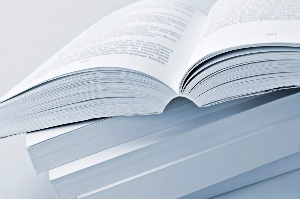 Perfect binding, the books are the perfect bind. Perfect bound using Pur refers to polyurethane, the type of glue used, which is much stronger and heat resistant than other paper based EVA glues.
Perfect binding, the books are the perfect bind. Perfect bound using Pur refers to polyurethane, the type of glue used, which is much stronger and heat resistant than other paper based EVA glues.
Perfect bound books are made up of stacked pages. These are gathered into a book and the edges of the spine are ground off (or notched). When the book block is glued into a paper cover, the pur glue that attaches the sheets to the spine can flow into the notches or ground-off areas. The covers and book blocks are then trimmed flush.
Perfect bound books are square at the spine and use glue to hold the pages, like a paperback book. It gives your books a more professional feel. It can accommodate a page count up to 640 pages (320 leaves 80gsm).
PUR is strong and eco-friendly. It is a popular glue due to it's superior binding strength and eco friendliness.
Lay-flat - PUR glue is more flexible than EVA glue and provides lay flat qualities when the book is opened. It is ideal for music books and cookbooks, which are read on the desk, and two-page spread such as photo books. This lay-flat quality makes it easy to read books and extends the book life.
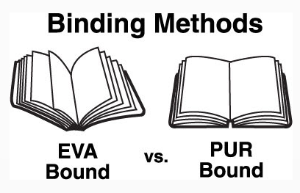 High Binding Strength and Durability - The binding strength is about three times stronger than the EVA glue. Coated paper or specialty stocks, which can be be a problem with EVA, are bound securely in PUR bound books. EVA glue binding strength becomes weaker over time. However, the PUR glue retains durability and flexibility in both high and low temperatures for long lasting book quality.
High Binding Strength and Durability - The binding strength is about three times stronger than the EVA glue. Coated paper or specialty stocks, which can be be a problem with EVA, are bound securely in PUR bound books. EVA glue binding strength becomes weaker over time. However, the PUR glue retains durability and flexibility in both high and low temperatures for long lasting book quality.
Another big advantage of perfect bind is that you can also have information printed on the spine.
 |
 |
 |
What Does A Perfect Bound Book Look Like - click here to view on YouTube.
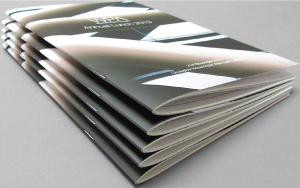
Saddle Stitch Booklet
The saddle stitch booklet catalogue is ideal for publications ranging from 8 pages to 100 pages. Typically, the finished size is A4 or A5 when closed, although we also offer custom sizes to meet your specific needs.
This style of catalogue generally features a heavier weight cover (200-300gsm) and content pages (80-150gsm), although some options maintain the same weight throughout for a uniform appearance.
Saddle stitching involves inserting two staples into the spine and folding the pages in half to create a booklet. This method is not only efficient but also the most economical option for finishing catalogues.
Square Fold Saddle Stitched
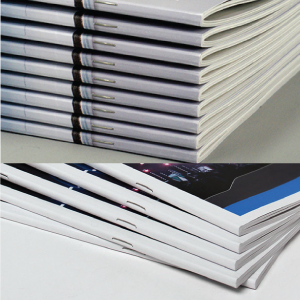 This is a smart new look for full colour books. The square fold produces creased cover sheets, and face trimming to create crisp, sharp square spine booklets that can be opened flat and are easy to handle, stack and store.
This is a smart new look for full colour books. The square fold produces creased cover sheets, and face trimming to create crisp, sharp square spine booklets that can be opened flat and are easy to handle, stack and store.
 |
 |
 |
Wire Binding
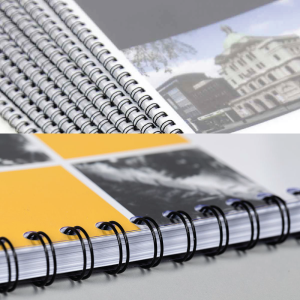 Wire bound catalogue—Wire binding is one of the most popular commercial catalogue binding methods used and is known by a number of different names including twin loop wire, Wire-o, double loop wire, double-o, ring wire and wirebind. With this binding method, the punched pages go onto a "C" shaped spine and then a wire closer is used to squeeze the spine until it is round. Documents that are bound with wire binding will open completely flat on a desk and allow for 360 degree rotation of bound pages.
Wire bound catalogue—Wire binding is one of the most popular commercial catalogue binding methods used and is known by a number of different names including twin loop wire, Wire-o, double loop wire, double-o, ring wire and wirebind. With this binding method, the punched pages go onto a "C" shaped spine and then a wire closer is used to squeeze the spine until it is round. Documents that are bound with wire binding will open completely flat on a desk and allow for 360 degree rotation of bound pages.
There are two common hole patterns used in binding documents with double loop wire. Each hole pattern has specific sizes and applications where it is best suited. Here is a quick overview of the different options.
3:1 pitch (3 holes per 25mm) Up to 120 80gsm leaves – 240 pages
The three to one pitch hole pattern is most commonly used for binding small sized documents with double loop wire. Spines for this binding style are available in sizes between 4.8mm and 14mm in diameter. Three to one pitch wires are not available in sizes larger than 14mm. The size of the holes used with this pattern simply does not allow for larger spines to be manufactured.
2:1 pitch (2 holes per 25mm) Up to 240 80gsm leaves – 480 pages
Although a two to one pitch hole pattern is most commonly used for binding larger sized documents it can also be used for binding smaller diameter books. Two to one pitch wire is most commonly used in sizes ranging from 15.9 mm up to 32mm. However, we can use special small sized 2:1 pitch wire for binding documents as small as 6.4mm.
 |
 |
 |
Plastic Comb Binding
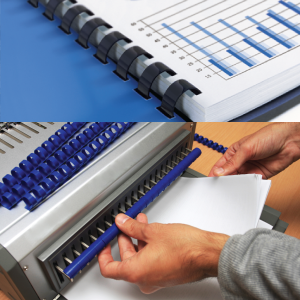 This binding method is good for technical manuals that have a lot of pages and must lie flat. The stack of pages comprising the book is punched with a series of holes along the binding edge through which a plastic comb is inserted.
This binding method is good for technical manuals that have a lot of pages and must lie flat. The stack of pages comprising the book is punched with a series of holes along the binding edge through which a plastic comb is inserted.
Plastic comb binding can accommodate a page count for circle ring of 500 pages (250 leaves), oval ring of 900 pages (450 leaves). Pages can be added or removed as needed. Available in a wide range of colours.
Plastikoil
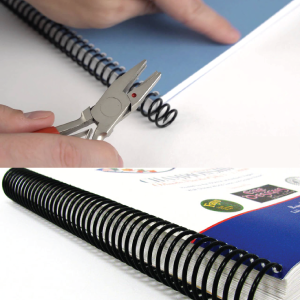 Also known as spiral binding, plastikoil is a commonly used book binding style for creating documents, reports, presentations and proposals. Documents bound with coil can open flat on a desk or table and offer 360 degree rotation for easy note taking. The continual spiral binding gives document security and ease of use to the end user. Standard color is black but other colors are available.
Also known as spiral binding, plastikoil is a commonly used book binding style for creating documents, reports, presentations and proposals. Documents bound with coil can open flat on a desk or table and offer 360 degree rotation for easy note taking. The continual spiral binding gives document security and ease of use to the end user. Standard color is black but other colors are available.
 |
 |
 |
What Does A Wire Bound Book Look Like - click here to view on YouTube.
Ring Binder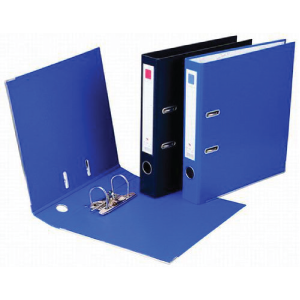
Ring binder catalogues are very useful for operational manuals or any type of manual or catalogue that is going to be updated. Pages can be easily removed and replaced. Inside pockets, 2, 3, or 4 ring binders are available.
Another popular option to consider when using ring binders is tabs that are used to separate topic sections. Tabs make it easy to find the right information in a ring binder quickly.
Contact us to discuss the catalogue options for you today!
Tabs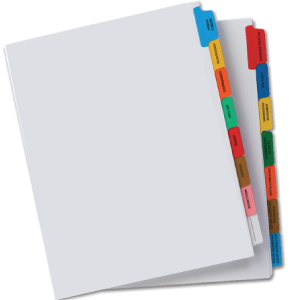
When combined with tabs, the binding methods mentioned above create user-friendly manuals that enhance navigation and accessibility. Tabs allow for quick reference to different sections, making it easier for readers to find the information they need at a glance. This is especially beneficial for training manuals, instructional guides, or reference books where users require efficient access to specific content.
If you’re considering a catalogue that incorporates these features, we’re here to help! Contact us today to discuss your options and discover how we can tailor a solution that meets your needs. Let’s work together to create a manual that is not only functional but also visually appealing and easy to use!
 |
 |
 |
Call (09) 579 5575 or
email: print@copydirect.co.nz
Looking for something special to promote your brand?

Binding History
Bookbinding is the process of physically assembling a book of codex format from an ordered stack of paper sheets that are folded together into sections or sometimes left as a stack of individual sheets. The stack is then bound together along one edge by either sewing with thread through the folds or by a layer of flexible adhesive. Alternative methods of binding that are cheaper but less permanent include loose-leaf rings, individual screw posts or binding posts, twin loop spine coils, plastic spiral coils, and plastic spine combs.
For protection, the bound stack is either wrapped in a flexible cover or attached to stiff boards. Finally, an attractive cover is adhered to the boards, including identifying information and decoration. Book artists or specialists in book decoration can also greatly enhance a book's content by creating book-like objects with artistic merit of exceptional quality.
Before the computer age, the bookbinding trade involved two divisions. First, there was stationery binding (known as vellum binding in the trade) that deals with books intended for handwritten entries such as accounting ledgers, business journals, blank books, and guest log books, along with other general office stationery such as note books, manifold books, day books, diaries, portfolios, etc. Computers have now replaced the pen and paper based accounting that constituted most of the stationery binding industry. Second was letterpress binding which deals with making books intended for reading, including library binding, fine binding, edition binding, and publisher's bindings. A third division deals with the repair, restoration, and conservation of old used bindings.
Today, modern bookbinding is divided between hand binding by individual craftsmen working in a shop and commercial bindings mass-produced by high-speed machines in a factory. There is a broad grey area between the two divisions. The size and complexity of a bindery shop varies with job types, for example, from one-of-a-kind custom jobs, to repair/restoration work, to library rebinding, to preservation binding, to small edition binding, to extra binding, and finally to large-run publisher's binding.
There are cases where the printing and binding jobs are combined in one shop. For the largest numbers of copies, commercial binding is effected by production runs of ten thousand copies or more in a factory.


Saddle-Stitching

Square Fold Saddle Stitch

Wire Binding

Plastikoil Binding

Wire Binding with a Printed Spine

Plastic Comb Binding

Ring Binding

Tabs

Catalogues






